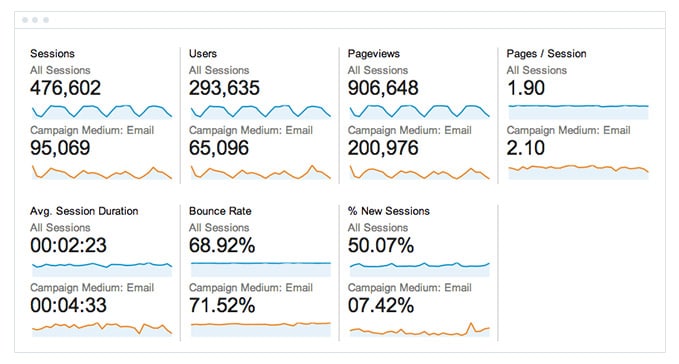7 ways to measure email marketing effectiveness
Is your email marketing as effective as it could be?
If you can’t answer this question without a lot of pausing, pondering, and guessing—it may be time to refine your measurement techniques. This way, you can answer this question confidently as your campaigns play out.
You may be tempted to rely solely on open rates and click-through rates to measure email marketing effectiveness, but there’s even more data you may want to consider. In fact, there are some key metrics that will give you a better idea of your effectiveness, depending on your goals.
By reviewing and tracking all metrics, you can get a better idea of how your email marketing messages are performing. Let’s talk about some ways to measure your email marketing effectiveness.
Email marketing effectiveness: 7 ways to measure without relying on opens and click-throughs
According to research, the most unreliable marketing metrics include open rates and unsubscribe rates. So, which metrics should you depend on to measure email marketing effectiveness? The list below should give you some good ideas.
1. Check the bounce rate on your email campaign landing pages
To measure how effective your emails are at setting up expectations, don’t look at the emails, themselves. Instead, check the bounce rate on the corresponding landing pages your emails are linking to.
Bounce rate, according to Neil Patel, is a measurement of the percentage of website visitors who land on your page but end up leaving immediately without doing anything else. In other words, they “bounce” off your site without sticking.
For email campaigns that point to landing pages, bounce rate can help you determine if the message and landing page line up. The email may successfully lead the reader from one page to another, but if readers aren’t staying long on your webpage, you’ll need to reevaluate how well your email and landing page content align.
Here’s an example email from Cloudventure. The example shows an email marketing message with links that successfully point to a landing page.
For emails like these, the success of the message and the success of the landing page are intertwined. How can you incorporate this into your own marketing?
2. Measure website traffic, too
You can also pinpoint how successful your emails are by analyzing what percentage of your total website traffic comes from your email marketing campaigns.
However, before you can access this metric, you’ll need to set it up in your tracking platform. For example, in Google Analytics, all traffic that comes from email will be lumped into the “direct” category (unless you help Google tell the difference between email traffic and direct traffic).
To do it, follow this guide to setting up campaign tracking. After you have it all set up, you’ll see your unique email campaigns in your traffic reports, like this:
You can use this data to figure out what percentage of your total traffic comes from email.
3. Look at the email conversion rate
The conversion rate is a measurement of how many of your email recipients clicked a link in the email and then completed a desirable action, such as:
- Making a purchase
- Downloading a lead magnet
- Filling out a form
- Signing up for a webinar
The conversion rate for your email campaigns will tell you how persuasive and actionable your emails are. To find it, you need to look at the total number of people who completed the action you wanted and divide that figure by the total number of emails sent and delivered. Multiply the result by 100 to get the conversion rate. (Still with us?) Here’s an example:
If 50 people completed the desired action after clicking a link in your email marketing message, and you sent out 500 total emails, the conversion rate formula would look like this:
- 50/500 = .1
- .1 x 100 = 10
- Conversion rate: 10%
4. Track your email list growth rate
Is your email list growth on track? Or is it falling off?
The effectiveness of your email marketing will have an effect on the size of your email list. If your emails are ineffective, your list size will decrease as old customers unsubscribe faster than new ones sign up.
On the other hand, if your emails have a winning formula, your list size will remain steady or grow.
To figure out your email list growth rate, you need a few metrics in hand:
- The number of new subscribers (A)
- The number of people who have unsubscribed (B)
- The total number of subscribers to your list (C)
Plug these numbers into this formula:
- A – B/C x 100
For example, if you have 100 new subscribers, but 50 people unsubscribed, and there are 1,000 total subscribers on your list, the formula would look like this:
- 100 – 50/1,000 x 100 = 5
- The email list growth rate with these numbers would be 5%.
5. Check the forward/share rate for each email campaign
Many email marketing campaigns aren’t focused on conversions or click-throughs, but rather the goal of trust-building through authoritative content. If this is the case, you might want to measure how many of your subscribers are sharing the content with others because they find it useful or interesting.
To do this, you need to look at how many people clicked a share or forward button in the email and divide that figure by the total number of emails delivered. Multiply the final figure by 100 to determine the percentage.
For instance, say 100 people clicked the “share this” or “forward to a friend” link/button in your email. If you sent out 20,000 emails, the formula would look like this:
- 100/20,000 x 100 = .5
- The forward/share rate for your email campaign would be .5%.
This email from Living Spaces is a good sample of marketing that includes social sharing buttons. From these, you can track the number of clicks.
6. Track your spam complaints
Are you providing value through your email marketing? Is the content useful and relevant to your subscribers? Or, let’s be honest, is it possible you’re flat-out annoying them?
To find out, keep tabs on your spam complaints. This metric looks at the percentage of people who marked your messages as “spam.”
The formula looks like this:
- Total spam complaints / Total number of emails delivered x 100
For example, if you received 50 spam complaints but you sent out 5,000 emails, your spam complaint rate would be 1%.
7. Measure the revenue from your campaigns to determine overall email marketing effectiveness
There are many ways to measure ROI (return on investment), but one of them can give you a birds’-eye view of how much revenue your email marketing campaign has netted.
To determine your email marketing campaign ROI, first, you need to establish a service level agreement (SLA) between marketing and sales. (Think of it like a handshake between the two departments, only this handshake lets you align your marketing/sales goals.)
The basic formula to determine ROI looks like this:
- The dollar amount of additional sales made from your email campaign – the total money you invested in the campaign / the total money invested in the campaign x 100
For instance, say you made $200 in additional sales and invested $100 in the campaign:
- $200 - $100 / $100 x 100 = 100%
- The campaign made a 100% return on investment.
Remember, this is only one way to track and measure ROI. Depending on your goals, you might want to approach it from a different direction.
Wrap up
Figuring out your email marketing effectiveness isn’t as simple as looking at a few (potentially unreliable) metrics like open rates. Instead, you need to dig a little deeper to get a clearer view.
To get a fuller picture of the health and success of your emails, think about integrating email with other platforms in your tech stack for more robust analytics. For instance, according to SalesForce, you can integrate email with:
- Marketing analytics (like website traffic)
- Sales
- Social media
- Search marketing
Overall, this approach gives you a better view of your email marketing. It reveals how email works with other facets of your marketing so you can get smarter about strategy. This is the key to better results in the long run. So, how will you apply these methods to your own campaign?
MOST RECENT ARTICLES
Want to engage your audience and grow your brand? Try Emma's robust easy-to-use product today.
















